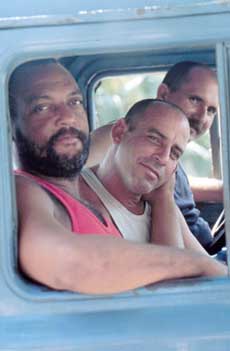 |
|
 |
Cubans 2001
photo by Mimi Chakarova
Times are changing rapidly for youth in Cuba.
When the Soviet bloc fell at the end of the last decade, everyone expected Fidel Castro to follow. Indeed, economic conditions in the early 1990s were as bleak as they've ever been for the island's 11 million people. A class from the Graduate School of Journalism visited in 1992 and signs proclaiming "socialism or death" dominated the landscape. Cubans had to make do. The end of Soviet financing meant a scarcity of everything from bread to gasoline. The streets were empty; so were the few, poorly stocked peso shops.
Socialism or death? Not exactly. As the black market exchange rate soared and Cubans became restless, the real choice became the dollar or death. Castro chose life and legalized the dollar. Once again it became important to see what had happened to the island so students from the Graduate School of Journalism and the Freshman Seminar Program visited again last spring. What a difference a dollar makes.
We found that the new greenbacks from tourism and remittances had triggered the most profound changes on the island since the 1959 Revolution. Adam Smith has replaced Marx. Well-stocked dollar stores abound and nearly every Cuban — legally or on the side — has become an entrepreneur. Juliana Barbassa writes about the new Cuban capitalist and Julian Foley visits Trinidad to profile a black market tourist guide. Alicia Roca travels across the island to see how the women in Manzanillo fare without dollars.
photo by Mimi Chakarova
Life is also changing for many workers around the country.
Archana Pyati looks at the latest wave of Cuban immigrants to the United States and the families they left behind on the island. The dollars such immigrants send home have created new inequities and Annelise Wunderlich meets the hip hop artists who have found music in the advent of a class structure. Other, more established figures in the cultural community, including those at the National Ballet that Ana Campoy finds, and the literary community that Ezequiel Minaya profiles, have turned the economic opening to their advantage. All of a sudden, a government that forbid artists to sell abroad is encouraging them to do so — and taking a cut.
At every turn, the question arises: Can Castro control the changes? The government remains highly centralized and block committees for the defense of the revolution still exist, but it's impossible to count on neighbor ratting on neighbor when securing dollars — mostly in illegal commerce — has replaced baseball as the national sport.
The question of control goes beyond the economy. John Coté demonstrates how ingenious Cubans subvert restrictions to access the Internet. And Bret Sigler finds Cubans in the small tobacco growing town of Pinar del Rio wondering if there is room for God, babalawos and Castro. Nearby in the town of Pilotos, Daniela Mohor shows how socialism can still make the best cigars.
We get a sense of Cuba's past from Olga Rodriguez who finds the true believers, the foreigners who remain loyal to the revolution; and from Angel Gonzalez who describes his journey to his family's home in Cameguey. Megan Lardner discovers the most ironic of historical twists: the Spanish whom Cubans spent decades trying to get rid of, are back.
All of this wandering and writing was made possible by the generous support of Orville Schell, dean of the Graduate School of Journalism and Harley Shaiken, director of the Center for Latin American Studies. In addition, Tom Engelhardt, helped inspire us and assisted on the editing.
Lydia Chávez
October 2001

